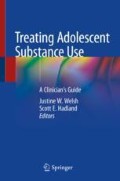Abstract
Families, schools, and communities play a critical role for adolescents with problematic substance use. These supports can mobilize to strengthen recovery with successful early problem recognition, cultivation of appropriate attitudes and behaviors, and engagement with treatment to reinforce sustained change. High-quality evidence-based treatment interventions targeting families, schools, and communities have demonstrated effectiveness and offer practical guidance for parenting and educating adolescents in treatment and recovery. This chapter provides an overview of evidence-based practices that help adolescents reduce or abstain from problematic substance use; develop the necessary social, emotional, behavioral, and cognitive skills to cope with the challenges of recovery; and ultimately thrive in a sober life.
Access this chapter
Tax calculation will be finalised at checkout
Purchases are for personal use only
References
Hogue A, Liddle HA. Family-based treatment for adolescent substance abuse: controlled trials and new horizons in services research. J Fam Ther. 2009;31(2):126–54.
Smith JE, Meyers RJ. Motivating substance abusers to enter treatment: working with family members. New York: Guilford Press; 2004.
Liddle HA. Multidimensional Family Therapy for adolescent cannabis users. Cannabis Youth Treatment (CYT) Series (Volume 5). Rockville: Center for Substance Abuse Treatment, Substance Abuse and Mental Health Services Administration; 2002.
Szapocznik J, Williams RA. Brief strategic family therapy: twenty-five years of interplay among theory, research and practice in adolescent behavior problems and drug abuse. Clin Child Fam Psychol Rev. 2000;3(2):117–34.
Alexander JF, Waldron HB, Robbins MS, Neeb AA. Functional family therapy for adolescent behavior problems. Washington, DC: American Psychological Association; 2013.
Henggeler SW, Clingempeel WG, Brondino MJ, Pickrel SG. Four-year follow-up of multisystemic therapy with substance-abusing and substance-dependent juvenile offenders. J Am Acad Child Adolesc Psychiatry. 2002;41(7):868–74.
Miller WR, Meyers RJ, Tonigan J. Engaging the unmotivated in treatment for alcohol problems: a comparison of three strategies for intervention through family members. J Consult Clin Psychol. 1999;67(5):688–97.
Meyers RJ, Wolfe BL. Get your loved one sober: alternatives to nagging, pleading, and threatening. Center City: Hazelden; 2004.
Liddle HA, Dakof GA. A randomized controlled trial of intensive outpatient, family-based therapy vs. residential drug treatment for co-morbid adolescent drug abusers. Drug Alcohol Depend. 2002;66:S2–S202, S103.
Greenbaum PE, Wang W, Hall K, et al. Gender and ethnicity as moderators: integrative data analysis of multidimensional family therapy randomized clinical trials. J Fam Psychol. 2015;29(6):919–30.
Henggeler SW, Schaeffer CM. Multisystemic Therapy®: clinical overview, outcomes, and implementation research. Fam Proc. 2016;55:514–28.
Santisteban DA, Coatsworth JD, Perez-Vidal A, Mitrani V, Jean-Gilles M, Szapocznik J. Brief structural/strategic family therapy with African American and Hispanic high-risk youth. J Community Psychol. 1997;25(5):453–71.
Barkley RA, Robin AL, Benton CM. Your defiant teen: 10 steps to resolve conflict and rebuild your relationship. New York: Guilford; 2008.
Trupin EJ, Kerns SEU, Walker SC, DeRobertis MT, Stewart DG. Family integrated transitions: a promising program for juvenile offenders with co-occurring disorders. J Child Adolesc Subst Abuse. 2011;20(5):421–36.
Botvin GJ, Griffin KW. Life skills training as a primary revention approach for adolescent drug abuse and other problem behaviors. Int J Emerg Ment Health. 2002;4(1):41–8.
Haggard LK. Reasonable accommodation of individuals with mental disabilities and psychoactive substance use disorders under Title I of the Americans with Disabilities Act. Wash U J Urb Contemp L. 1993;43:343.
Stewart DG, Siebert E, Arlt VK, Moise-Campbell C, Lehinger E. READY or not: findings from a school-based mi intervention for adolescent substance use. J Subst Abus Treat. 2016;71:23–9.
Finch AJ, Tanner-Smith E, Hennessy E, Moberg DP. Recovery high schools: Effect of schools supporting recovery from substance use disorders. Am J Drug Alcohol Abuse. 2018;44(2):175–84.
Levy S, Siqueira LM, Committee on Substance Abuse, Ammerman SD, Gonzalez PK, Ryan SA, Siqueira LM, Smith VC. Testing for drugs of abuse in children and adolescents. Pediatrics. 2014;133(6):e1798–807.
Evans-Whipp T, Beyers JM, Lloyd S, Lafazia AN, Toumbourou JW, Arthur MW, et al. A review of school drug policies and their impact on youth substance use. Health Promot Int. 2004;19(2):227–34.
National Association of School Nurses. Naloxone use in the school setting: the role of the school nurse (Position Statement). 2015. https://www.nasn.org/advocacy/professional-practice-documents/position-statements/ps-naloxone. Accessed 10 Aug 2018.
Kelly JF, Myers MG, Brown SA. A multivariate process model of adolescent 12-step attendance and substance use outcome following inpatient treatment. Psychol Addict Behav. 2000;14(4):376–89.
SAMHSA, Office of Applied Studies, 2008, as cited in Community Anti-Drug Coalitions of America (CADCA). Research support for comprehensive community interventions to reduce youth alcohol, tobacco and drug use and abuse. Research and Evaluation White Paper Series, 2010, 1.
Burris S, Beletsky L, Castagna CA, Coyle C, Crowe C, McLaughlin JM. Stopping an invisible epidemic: legal issues in the provision of naloxone to prevent opioid overdose. Drexel L Rev. 2009;1:273–340.
Author information
Authors and Affiliations
Corresponding author
Editor information
Editors and Affiliations
Rights and permissions
Copyright information
© 2019 Springer Nature Switzerland AG
About this chapter
Cite this chapter
Stewart, D.G., Chu, A., Rappaport, N. (2019). Role of Families, Schools, and Communities in Treatment and Recovery: From First Responders to Sustained Support. In: Welsh, J., Hadland, S. (eds) Treating Adolescent Substance Use. Springer, Cham. https://doi.org/10.1007/978-3-030-01893-1_10
Download citation
DOI: https://doi.org/10.1007/978-3-030-01893-1_10
Published:
Publisher Name: Springer, Cham
Print ISBN: 978-3-030-01892-4
Online ISBN: 978-3-030-01893-1
eBook Packages: MedicineMedicine (R0)

